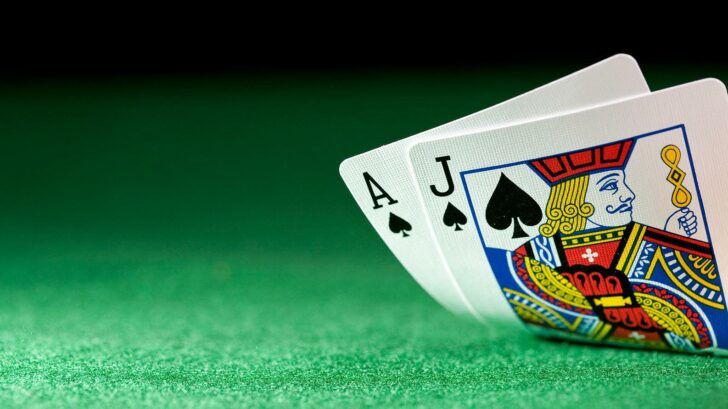A Simpler Card Counting System: the 21+3 Side Bet

Casinos love to look for an extra edge in every game. In fact, they’re always looking for ways to make each game harder for the gambler to win big on. Blackjack is no exception.
While there have been many additions over the years, one of the current favorites amongst casinos the world over is the 21+3 bet. This side bet is to be found on blackjack tables from London to Sydney and its premise is a simple one.
When you are dealt a hand, you can see 3 cards straight away: your two and the dealer’s face up card. Sometimes these 3 cards are suited, or even the same number. In other words, poker hands. Why not bet on whether that poker hand comes up, then?
The odds of the 21+3 bet
The first thing any gambler should think about before making a bet is: what are the odds I will win? There’s no point playing if the odds of winning are 0%. Likewise, the casino isn’t going to offer the game if the odds of winning are 100%.
Yet there is a different calculation that is even more important: the house edge. This is the %age of a bet that the house can expect to win. If someone bets $100 and the house edge is 3.5%, the house should, on average, win $3.50.
The house edge on the most common form of 21+3 – in Vegas at least – is 3.24%. This means each time you bet, you will only bring back 97 cents in every dollar.
That’s not all, though, as the chance of actually winning at 21+3 – without any assistance – is less than 10%. So, you need to bet 10 times to win $9 once. Yeah, I think I’ll pass on that one, thanks.
Luckily that’s not the end of the story
There is a different way to bet, though, and it involves something glamorized in films such as 21: card counting systems.
Unlike counting on the main game, counting on a side bet is not only often easier, but it also disguises your count: your betting patterns will not follow those of a normal card counter.
There have been many side bets used in Blackjack history
• Super Sevens pays out when you have 7s in your hand
• Over/Under 13 let you bet on whether your hand would be worth more or less than 13
• Lucky Ladies pays out when you have 20
So not only is counting your way through 21+3 a good idea for newcomers to card counting, but a good idea for experienced pros to hide their normal game. How do you do it, though?
Well, there are two different systems for counting when it comes to 21+3, but they both have one thing in common…
Both counts focus on the flush. Trying to count number cards is just too hard: there are 13 different possibilities. Instead the focus is on the 4 possible suits.
First is the most simple of the two counts. This can even be implemented alone, as a side count of just one suit. The main advantage this will give – along with any winnings, of course – is that the pit boss will turn his attention away from you. You are dropping money on what he considers a suckers bet, after all.
A 1 in 4 chance
First up, there’s counting 1 suit. The best way to pick a suit is by seeing whichever comes out the least in the first round of dealing.
Then, each time a card of that suit is dealt, take 1 away from your total. Each time 4 cards are drawn, add 1 to your total. Lastly, you need to divide your count by the number of decks left in the shoe.
It may not be the most complicated card counting system, but it will give you a slight edge. When your count gets to +4 or -5, it’s time to bet big, as the chances of three suited cards appearing increases enough to give you an advantage.
The problem with the count, however, is that you’re only counting a quarter of the cards. So there’s a good chance you could go a whole game without seeing your suit come up. Better then to count more than one suit…
That’s not the easiest thing to do, though, especially for a beginner counter.
Count in teams
So why not join with a group of friends and start counting together? Get together a group of 4 or 5 friends and head down to the casino for a night of blackjack action with big rewards.
If everyone counts a single suit, then you’ll have the whole shoe under your thumbs. Every time one of you bets on the 21+3 side bet, everyone should do the same. Within no time, you’ll have bought in a whole heap of cash, so long as luck goes your way, that is.
Be careful not to get caught, though. While one person betting on a side bet is likely to be ignored, a whole table doing the same thing is most likely to be noticed, especially if the house ends up somewhat down.
There is another method, too
Instead of giving each person a suit to count, there is an even better way to ensure you have the best chance of increasing your advantage. Instead of counting a suit, you need to count the difference between two suits.
Let’s say you’re counting the difference between hearts and clubs: every time you see a heart, add 1 to your score, and every time you see a club, take 1 away. Divide by the number of decks left in the shoe and you’ve got your true count. Should your score ever get to + or – 7, you’ve got an advantage and should bet.
The problem with this is that it only covers 1/6th of the possibilities. So, like above, you need 6 people – or someone with an incredible mind – to count the whole shoe. Again, everyone should bet when one of the counters does, but mind your casino table manners: you don’t want to be caught and thrown out.
So that’s it. While it may not be the simplest way to play blackjack, 21+3 does at least give you a way to exploit the table while still remaining relatively inconspicuous. Perhaps it’s that thing that makes this blackjack tip a real choice for gamblers looking to increase their odds.







